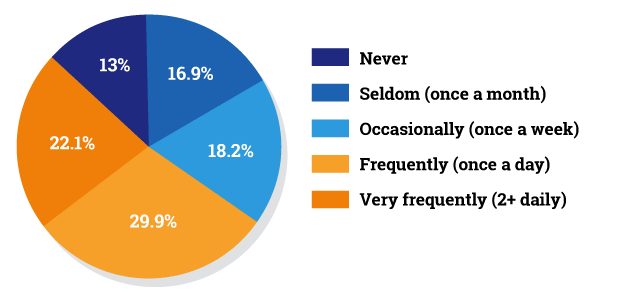Having just conducted two webinars on the topic of how to build a social media program for your school or district, it’s quite obvious to us that the elephant in the room that is social media for schools, is, well, let’s say trending. Because many schools don’t know where to begin, however, the social media landscape still remains a largely uncharted frontier.
Savvy school communicators realize the viral potential of social media to do great things for their school, but many frankly aren’t doing much about it.
A recent poll conducted by the SchoolNow showed that schools using an official social media account never, seldom, or on rare occasion outnumber those schools using it frequently (once a day) or very frequently (several times daily) by a margin of 2-1.
Where does your school stand with social media?
So why does the number of non-users double the users? (And frankly, once a day is not nearly frequently enough to have much of an effect.) Most schools are not sure how to start.
Of all the advice I’ve either seen or given on how to jump into the social media pool, I can sum it up simply by saying, go ahead and jump. Don’t dive head first; test the water first with your big toe, but definitely get in the pool. The best way is to put together a social media plan, and start small. I’ve pulled together some advice and social media resources in this article and on how to go about implementing social media at your school.
Frequency of schools posting on social media

For both the one-off private schools and the multi-school public school districts, it’s apparent that only some schools are implementing social media policies and programs to extend the reach of their communications programs.
Private schools administrators know that, on paper, social media can boost their enrollment and fundraising efforts, but how? Public school PR and communications directors can’t let the negative (and very rare) social media scandal stop them from developing powerful social media strategies to help with everything from passing tax levies to spreading all the good school news happening in the district.
The resounding message that we’re all learning as we continue our dialogue with schools across the country is that we must not bury our heads in the sand when it comes to social media, and that by getting out in front of it – that is, manage it like any other communications tool – this phenomenon is anything but trendy, but a powerful ally in telling your school story and building strong relationships with students, parents and your school community.
As providers of content management systems for schools, SchoolNow is at the nerve center of where social media intersects with the school website: the heart of your school’s web-based communications. We are watching social media and its potential with a careful eye, to the extent that we build social media management tools into our own school website software.
Because of our extensive experience with social media, we’ve picked up some best practices that are easy to implement. Work some of these practices into your social media game plan and you’ll likely see immediate results.
Use a schedule.
One of the biggest frustrations with social media that we hear from schools is that they just don’t know when to use it. Are you supposed to keep every social network open all day? How often should you post? How do you be communicative without also being a pest?
These are all good questions. Social media doesn’t have to be a mystery. In fact, each network has its own unspoken rules about how much posting is too much. Buffer - a very useful social media tool - has shared their own internal rules for posting to their accounts. Keep in mind, many of the best practices surrounding social media posting frequency are based on consumer or business-to-business applications. What best works for schools is being sorted out, but stay tuned to the SchoolNow blog for more on that.
LinkedIn and Facebook are generally only once or twice per day networks. Twitter is different. It’s its own animal. Most of your tweets there will only be seen by a small percentage of your followers, so it’s okay to tweet a dozen or more times per day.
You can relieve much of the pressure by setting a similar schedule for yourself. You can then use a social planning tool to schedule many of your posts in advance. Test different times and types of posts to see what gets the best interaction and response. Once you have your system down, you can set a schedule and execute your social strategy in just a couple of hours a week.
Use the 'cocktail party' approach.
Another big concern we hear from schools who are new to social media is that they don’t know exactly how to interact on social media. Are you trying to persuade people to buy something or take some action? Is it just about making connections? What’s the point?
In a very general sense, the point is that hopefully your audience will find you interesting - enough so that they’ll seek out more information on your website or from you directly. How exactly does one do that?
One good rule of thumb is to use the cocktail party approach. Think about the last time you were at a dinner with friends, a cocktail party, or a networking event. What are some of the unwritten rules about those kinds of functions?
First, you should listen more than you talk. No one wants to be in a conversation with someone who only talks about themselves. You also don’t want to be seen as a salesperson. Rather, you want to be interesting. You want to share stories or information that others at the party will find entertaining or insightful.
Finally, you want to be yourself. Phonies are easy to spot, whether you’re at a party or on Facebook. Be sincere and transparent and you’ll get a much better response.
Create, curate, and ask. The final big concern that we hear from schools is that they just don’t know what to post. Far too many default to easy and standard posts like school announcements and links to information, like the school lunch schedule. While that kind of content is certainly acceptable, it’s likely not the kind of thing that’s going to excite and engage your audience.
[divider_flat]
Share 3 kinds of social media content.
Try to split your social content between three different categories, original, borrowed, crowd-sourced.
1. Content you’ve created.
This could be blog posts on your website, videos from classrooms or school events, or even photos or graphics. Ask your teachers and students to contribute to the content creation process so it doesn’t all fall you and your team.
2. Curated content.
Social media is built on sharing. Look for content that your audience will find useful. It could be an article with parenting tips or a guide to studying hacks. Retweet, share, and be sure to give credit where credit is due. Curation is an easy way to fill your social content schedule.
3. Content from your audience.
Ultimately, you want to engage with your audience. Why not go straight to the source and ask them questions? Make sure the questions are open ended and related to topics that your audience will find interesting. Also, try to ask questions that will get your audience interacting with each other. For instance, you could ask what parents are doing to help their kids get their homework done each night. Or you could ask students what they’d like to see added to the cafeteria’s offerings. This is a great way to spark discussion and get your audience to create content for you.
Social media doesn’t have to be a mystery. In fact, it’s actually not too difficult once you get started. The best thing you can do is jump in and try it. Experiment with different types of posts and posting times to see what works best. You’ll probably be a social expert in no time at all.
Topics: School Districts Private schools Social media
About the author
Marketing director and content strategist for SchoolNow, Jay’s a former school public relations specialist who’s helped businesses, schools and colleges use the power of communications to improve their image, generate support, and optimize relationships. Reach him at jay@schoolnow.com.
.png?width=64&height=63&name=Group%20(4).png)
.png?width=66&height=64&name=Group%20(5).png)
.png?width=56&height=60&name=Group%20(6).png)
.png?width=66&height=52&name=Group%20(7).png)
.png?width=56&height=56&name=Group%20(9).png)
.png?width=59&height=52&name=Group%20(10).png)


